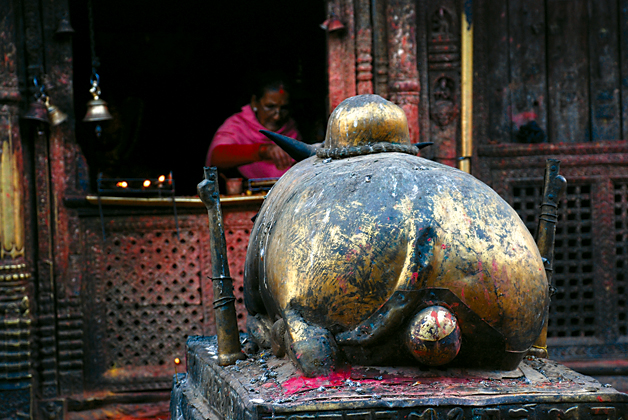
You don’t say!
Out of hundreds of Ganesh shrines in the Valley, the one just in front of Banglamukhi temple in Patan is very special. Instead of a rodent, Ganesh’s traditionally ‘official’ mount, you’ll find an ox standing guard. Inside the Banglamukhi temple complex another Ganesh mandir (temple) tells the same story. Whatever happened to Ganesh’s rat? Has the ox taken over? Has it trampled the poor rat under its strong hoofs?
Can I borrow your ride, dad?
“What I really like dad,” sang Ugly Kid Joe in their rendition of the song ‘Cat’s in the Cradle’, “is to borrow the car keys. See you later, can I have the keys?” Nothing has spruced up the parent-child relationship more than handing down of the crucial life skills, such as driving. The moment the child touches 18, or lingers near, he wants to reign supreme behind the steering wheel. He wants to honk till it doesn’t sound like music, punish the engine burning the rubber tires bald (like they do in movies) and fiddle with the control knobs till he can do it with his eyes closed. And, oh—he wants to glue his foot to the gas pedal, too.
Of course, you’d like to think all this started because the horsepower finally caught up with horse-drawn-power. But you’d be surprised that this particular ‘issue’ has been in existence from way back. Way, way back; back from the days of the gods, for starters.
So unfair!
And gods? Now, they also need to travel. And, for that very purposes, they each have their own ‘vehicles’—albeit live ones. Shiva has an ox, and Kumar glides along on a peacock, while Vishnu rests comfortably on the king of serpents, floating down the cosmic ocean. But for reasons that are above most of us, the pot-bellied, cuddly, most adorable god of them all, Ganesh, has to suffice with Musak Raj (The King Mouse) to haul his mammoth body (sorry, pun not intended!) around. So unfair! And, that’s why, on important occasions, when taking his trusty rodent would have been out of question, Ganesh hikes up to Mount Kailash (Shiva’s abode), pays a courtesy call on his dad, make a straight face and asks: “Can I borrow your ox?”
Mount me this
Almost everybody has seen the statue of a tiny rodent up and about in Ganesh shrines, scattered across the valley. But, had they been watching—nay, observing closely—they would have seen something quite profound in some Ganesh shrines. If you look closely, you too shall see a statue of an ox standing vigil in front of some Ganesh temples. Yes, you heard that right: an ox.
Much like the ox guarding the Shiva mandir, the ox in Ganesh shrines also shares the same attributes. Whereas the rat would have been carved somewhere near the god or in front of the temple facing the same direction that Ganesh is facing, the statue of the ox stands lonely, facing the temple. Like the legendary soldier of Pompeii who stood guard even as the volcano erupted all around him, the ox holds the fort. Only in that attribute it is similar to the ones that stand guard in front a Shiva mandir. As there are similarities, there are bound to be some differences as well. It does not require Sherlock Holmes’ deduction skills to figure it out; a keen eye will suffice.
Well done, Sherlock!
The statue of the magnificent ox welcomes the visitors in Pashupatinath temple complex. While it’s not known if the master craftsmen left it on purpose, the huge, bulging... umm, ahem, ahem, cough... sacks of you-know-what... cough, cough... certainly gives the visitors quite an eyeful. That little bit of anatomy protruding from the ox’s statue is the common design element featured in all Shiva mandirs in the valley. It’s a ubiquitous element you’ll find in every Shiva shrine, even the forgotten ones. That feature, however, is not found in the Ganesh shrine. Phew! Most people will heave a long sigh of relief after reading this. Maybe Shiva thought that his son couldn’t really ‘control’ the fully grown ox and gave him a much younger one, like the miniature version of motorcycles they sell at the supermarkets. That’s highly likely.
A priceless moment
“That’s to show,” says Ram Chandra Amatya, resident of Patan and a cultural historian, “that Shiva cared for Ganesh, his son. He cared enough to honor Ganesh’s request.” It must have been a priceless moment, when Shiva helped Ganesh on his new ‘ride’. To celebrate the moment, the father and son team had a master craftsmen to cast the moment in stone (no ‘Kodak moment’ back then). Then Shiva must have taken the craftsmen aside and asked to edit some specific ‘anatomical references’ from the final piece.








